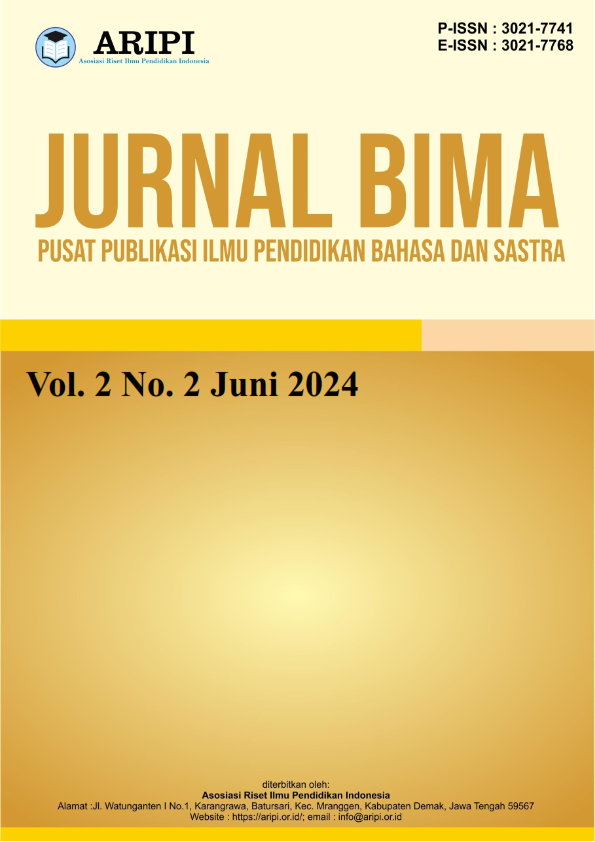The Urge to learn English: Breaking the Stigma of English as Bahasa Kafir (Infidel Language)
DOI:
https://doi.org/10.61132/bima.v2i2.851Keywords:
Stigma, English language, Bahasa kafir, Infidel languageAbstract
English is often considered a "Bahasa Kafir" or infidel language and is associated with Western values conflicted with certain religious beliefs. This literature research explores the origins of this stigma and why English is perceived as such. This article aims to break the stigma associated with English by analyzing cultural, historical, and religious contexts. Through a literature review, researchers highlight the importance of understanding that language is a universal communication tool not tied to a particular religion or culture. In contrast, English has values that transcend cultural and religious boundaries. Although such stigma can hinder access to educational and professional opportunities, a deeper understanding of English can broaden our view of the world, open the door to cross-cultural collaboration, and promote a deeper understanding of human diversity. Therefore, examining why English is considered a “Bahasa kafir” can provide valuable insight into how cultural biases and prejudices can influence how people think and interact.
Downloads
References
(2022). College students’ motivation and attitudes towards learning English as a global language: Perspectives from Indonesia and Malaysia. Kasetsart Journal of Social Sciences, 43(2). https://doi.org/10.34044/j.kjss.2022.43.2.11
Alsolami, T. (2020). The spread of English among Saudis in the era of globalization: A friend or a foe? https://doi.org/10.33422/2nd.icmetl.2020.11.91
Amri, S., & Bemak, F. (2013). Mental health help-seeking behaviors of Muslim immigrants in the United States: Overcoming social stigma and cultural mistrust. Journal of Muslim Mental Health, 7(1). https://doi.org/10.3998/jmmh.10381607.0007.104
Casey, P. (2017). Stigmatized identities: Too Muslim to be American, too American to be Muslim. Symbolic Interaction, 41(1), 100-119. https://doi.org/10.1002/symb.308
Chapman, M. (2016). Veil as stigma: Exploring the role of representations in Muslim women's management of threatened social identity. Journal of Community & Applied Social Psychology, 26(4), 354-366. https://doi.org/10.1002/casp.2269
Çiftçi, A., Jones, N., & Corrigan, P. (2013). Mental health stigma in the Muslim community. Journal of Muslim Mental Health, 7(1). https://doi.org/10.3998/jmmh.10381607.0007.102
Elyas, T. (2014). English in the Kingdom of Saudi Arabia. World Englishes, 33(1), 128-142. https://doi.org/10.1111/weng.12073
Hasan, M. (2014). Islam’s encounter with English and Ismail al-faruqi’s concept of Islamic English: A postcolonial reading. American Journal of Islam and Society, 31(2), 1-21. https://doi.org/10.35632/ajis.v31i2.287
Irawan, Y. (2020). Situating Islamic values in English language teaching. Islamika Jurnal Ilmu-Ilmu Keislaman, 20(01), 95-103. https://doi.org/10.32939/islamika.v20i01.617
Jailani, A., Halim, N., & Narasuman, S. (2020). The perceived influence of the English language on Islamic identity and value of students enrolled in an Islamic-oriented human resource education program. International Journal of Academic Research in Business and Social Sciences, 10(6). https://doi.org/10.6007/ijarbss/v10-i6/7329
Lauder, A. (2008). The status and function of English in Indonesia: A review of key factors. Makara Human Behavior Studies in Asia, 12(1), 9. https://doi.org/10.7454/mssh.v12i1.128
Lowenberg, P. (1991). English as an additional language in Indonesia. World Englishes, 10(2), 127-138. https://doi.org/10.1111/j.1467-971x.1991.tb00146.x
Madkur, A., & Albantani, A. (2018). Instilling Islamic values in foreign language teaching: An Indonesian context. https://doi.org/10.2991/icems-17.2018.20
Mahboob, A. (2009). English as an Islamic language: A case study of Pakistani English. World Englishes, 28(2), 175-189. https://doi.org/10.1111/j.1467-971x.2009.01583.x
Nurbaiti, N., Nailufar, Y., Harun, R., & Usman, B. (2020). University students' motivation in learning Arabic and English as foreign languages in Aceh. Langkawi Journal of the Association for Arabic and English, 6(2), 87. https://doi.org/10.31332/lkw.v0i0.1981
Paradewari, D., & Mbato, C. (1998). Language attitudes of Indonesians as EFL learners, gender, and socio-economic status. LLT Journal a Journal on Language and Language Teaching, 21(1), 114-123. https://doi.org/10.24071/llt.2018.210112
Resmini, S. (2019). EFL students’ perception towards the use of Bahasa Indonesia in an English classroom. Eltin Journal Journal of English Language Teaching in Indonesia, 7(1), 12. https://doi.org/10.22460/eltin.v7i1.p12-22
Ryan, L. (2011). Muslim women negotiating collective stigmatization: ‘We’re just normal people’. Sociology, 45(6), 1045-1060. https://doi.org/10.1177/0038038511416170
Saiful, J., & Widodo, P. (2018). Indonesian English teachers' attitude towards the English language. https://doi.org/10.2991/iccsr-18.2018.10
Saputra, N., & Asirah, A. (2022). EFL students' perceptions toward the integration of Bahasa Indonesia (L1) in English language teaching. Jo-ELT (Journal of English Language Teaching) Fakultas Pendidikan Bahasa & Seni Prodi Pendidikan Bahasa Inggris IKIP, 9(2), 185. https://doi.org/10.33394/jo-elt.v9i2.6350
Stojkow, M. (2019). Muslim women in the mirror - The stigma of Muslim women in Poland. Studia Humanistyczne Agh, 18(1), 81. https://doi.org/10.7494/human.2019.18.1.81
Umam, C. (2014). Maintaining Islamic values in English language teaching in Indonesian pesantrens. Didaktika Religia, 2(1). https://doi.org/10.30762/didaktika.v2i1.139
Wati, S. (2018). Language attitude of undergraduate students towards English at English education department. Lingtera, 5(1), 10-18. https://doi.org/10.21831/lt.v5i1.8583
Weichselbaumer, D. (2019). Multiple discrimination against female immigrants wearing headscarves. ILR Review, 73(3), 600-627. https://doi.org/10.1177/0019793919875707
Zia, B., & Mackenzie, C. (2024). Internalized stigma negatively affects attitudes and intentions to seek psychological help among Western Muslims: Testing a moderated serial mediation model. Stigma and Health, 9(1), 71-80. https://doi.org/10.1037/sah0000314
Downloads
Published
How to Cite
Issue
Section
License
Copyright (c) 2024 Jurnal Bima : Pusat Publikasi Ilmu Pendidikan bahasa dan Sastra

This work is licensed under a Creative Commons Attribution-ShareAlike 4.0 International License.






